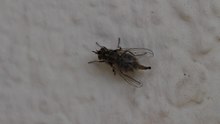Calf stick
| Calf stick | ||||||||||||
|---|---|---|---|---|---|---|---|---|---|---|---|---|

Calf stick ( Stomoxys calcitrans ) |
||||||||||||
| Systematics | ||||||||||||
|
||||||||||||
| Scientific name | ||||||||||||
| Stomoxys calcitrans | ||||||||||||
| ( Linnaeus , 1758) |
The calf trigger , calf bite or the common biting fly or stinging fly ( Stomoxys calcitrans, from Greek στόμα stoma , mouth, mouth ', ὀξύς oxys ' sharp, pointed' and Latin calcitrare ' kick back', see harmful effect ) is a fly from the family of Real flies (Muscidae). It is widespread worldwide and looks quite similar to the housefly , but differs from it by the proboscis that is clearly visible to the naked eye, which protrudes horizontally below the head (see picture opposite) and by the rounded abdomen.
features
The flies become six to seven millimeters long. Unlike the house fly, they have a forward, pointed proboscis (see proboscis ), which clearly extends beyond the head. They are hematophagous , so they suck blood . The maxilla and mandibles are absent, the lancing function is performed by the labium and labrum with the internal hypopharynx . The calf sticks are capillary suckers .
The mainly diurnal adults fly from June to October, but more often in late summer and autumn; the heat-loving biting flies like to stay in and around sheds, stables and living rooms.
Multiplication
After sucking blood three or four times over the course of about seven days, the females usually lay 600 to 800 eggs on animal droppings (e.g. from cattle, horses, chickens) and on dung heaps with rotting organic material in clutches of 60 to 270 pieces. This is where the larvae then develop . Hibernation can take place in both the larval and pupal stages. The development is strongly dependent on temperature and can take about 4 weeks at 19 ° C, but in 10 days at 33 ° C.
Harmful effect

Unlike the brakes (tabanids) or most mosquitoes bite in the Commons Stechfliege both sexes and suck the blood of humans and domestic animals. The suction process usually takes about 8 to 9 minutes.
In farm animals, bloodsucking can lead to a reduction in the milk yield and the amount of meat and fat, as the animals are constantly disturbed by the stinging imagines .
Common biting fly as a disease vector
The leg gnaw is an intermediate host for a number of pathogens that can be transmitted through the sting.
A mechanical transmission of the EIA virus , which belongs to the lentiviruses , of bacteria and other pathogens has also been established. The proboscis of the common biting fly is large enough to temporarily store all these pathogens in sufficient quantities for an infection inside and outside , like in an injection cannula . If a blood meal is interrupted on an infected animal or human, they can transfer infectious blood adhering to their mouthparts over a short distance within about 30 minutes to a neighboring animal or human that has not yet been infected.
See also
Web links
- Stomoxys calcitrans L. - Calf stick - Stable Fly. ( Memento from August 6, 2013 in the Internet Archive )
Individual evidence
- ↑ René van den Hoven: Equine Infectious Anemia and its status in Austria and its neighboring countries. In: Newsletter Horse Clinic. No. 4/2012 ( PDF file ).
- ↑ Stomoxys calcitrans L. - Wadenstecher - Stable Fly ( Memento from August 6, 2013 in the Internet Archive ).
